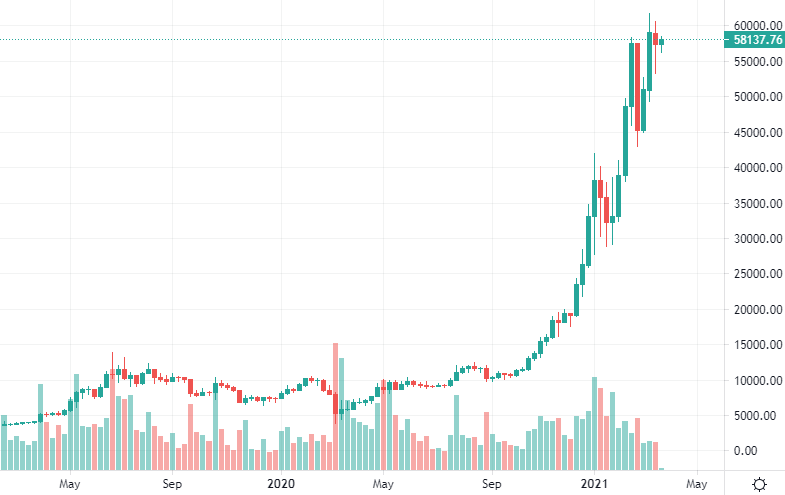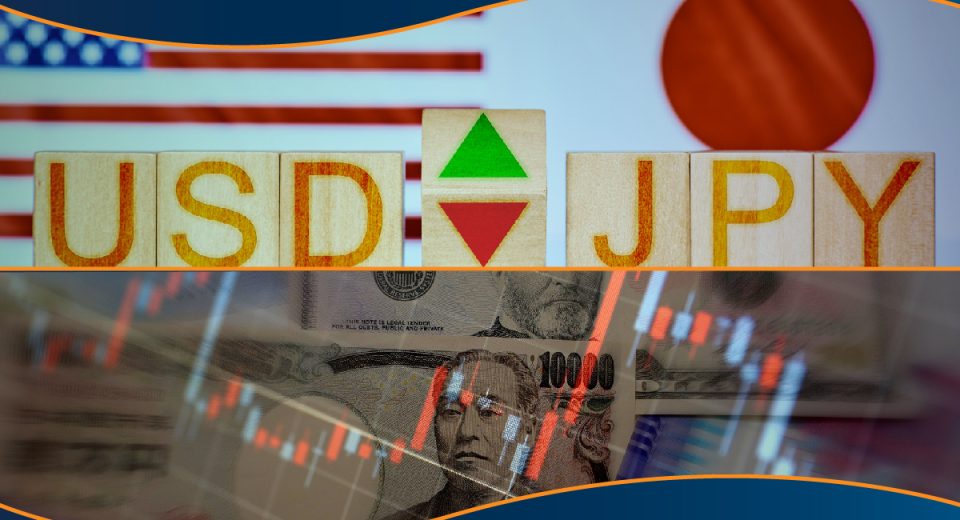How Bitcoin Reached $60K

Bitcoin reached an all-time high in mid-March. What factors lifted the crypto king, doubling its price from January? Let’s have a look How Bitcoin Reached $60K.
Bitcoin has reinforced its dominance so far in 2021, strengthening its position as the king of the crypto space. This came as a great relief to investors, after the sharp downturn in bitcoin prices with the onset of the pandemic in 2020. As the pandemic infected global financial markets, it caused a liquidity crisis. This in turn led to traders shunning bitcoin and moving to safe-haven assets like gold, resulting in the virtual currency losing almost 50% of its value within a week. By May, bitcoin bulls flexed their muscles again and BTC/USD returned to pre-pandemic levels. After that, the virtual currency maintained its upward momentum and breached the $20,000 barrier in December, closing the year at $28,992. Bitcoin raced ahead in the new year. Merely 8 days into the year, the crypto king had broken the $40,000 mark.
Those who argued about bitcoin already being overvalued had a surprise in store. By March 19, the cryptocurrency had smashed the $60,000 level. Those who purchased BTC/USD in mid-December would have tripled their investment in merely 3 months. The cryptocurrency has beaten most other major assets in the post covid-19 era and has earned its place as an investment that bears consideration. Understanding bitcoin price movements during this period of risk-on behaviour is key to predicting its future trends.

Sell Side Factors
The Halving
A core feature of bitcoin is its deflationary nature. This cryptocurrency is generated by mining, with the quantity capped at a 21 million. That means that after there are 21 million coins in circulation, the only circulatory changes would be bitcoins lost through forgotten passwords or hardware damage. This makes the currency net deflationary.
BTC’s scarcity is an essential component of its price. The regular clamp down on supply helps push prices up. Also, a further price hike is seen due to smaller miners exiting the network.
Also, to incentivise miners to create blocks, mining rewards are set to be retained until 2140. The assumption is that by then, BTC will be a mature currency. To enable mining rewards to be extracted till 2140, rewards are halved every 4 years. This function suppresses bitcoin supply further, as the cryptocurrency matures. The last halving event was on May 11, 2020. There were massive capital inflows into bitcoin, both in the run-up to and after the event. This helped bitcoin cross the $10K barrier in June.
Investor Side Factors
Institutional Acceptance
While bitcoin had already grabbed the attention of institutional investors, 2020 was a year that saw these investors adding the coin to large portfolios. This was a critical step towards bitcoin becoming mainstream. Even investment banks like JPMorgan, which had been sceptical about BTC in the past, got behind the cryptocurrency. JPMorgan analysts noted that bitcoin could reach as high as $146,000 if it begins to replace gold in portfolios.
Business Intelligence giant MicroStrategy announced and executed purchases of bitcoin as a store of value. Transaction-based firms like Mastercard, Visa and PayPal allowed transactions in cryptos, further supporting price increases. In fact, PayPal’s acceptance caused the market to rally 7% to hit a yearly high in October. Institutions have also launched attractive and novel products such as MicroStrategy’s Bonds-for-Bitcoin offering.
Elon Musk’s tweets with #bitcoin helped prices rise by around 20% in just 2 days after they were posted. Both Musk and Tesla invested $1.5 billion in January into bitcoin to maximise returns on their non-strategic cash reserves. BTC/USD spiked nearly 25% within a week.
Who Else is Buying?
Price behaviour is also the product of the type of buyers that dominate the market. Crypto analysts Chainalysis found that long-term investors hold 80% of the bitcoin in circulation. Retail crypto trades make up 85% of the trade value received by exchanges. OKEx Academy found that retail transactions helped propel BTC/USD to its then all-time high of $19,850 in November. Buoyed by the desire to secure alternate income streams and encouraged by mainstream and social media, retail investors continued to buy more than they were shorting this asset in the post-covid-19 period.
Investor behaviour also became incredibly risk-on, as liquidity returned to the market with the beginning of the new year. With not many alternatives to gain meaningful returns, investors flocked to the high-risk, high return the cryptocurrency offers.
Policy and Macroeconomic Expectations
Probably the single most important driver of prices were the macroeconomic expectations of investors. There was an immediate flight to safety when economies went into lockdown in March. Investors reacted by liquidating their BTC holdings to cover other positions, hedge uncertainty, and meet cash needs. Bitcoin prices fell by 50% in the week ending March 16.
However, record fiscal and monetary stimuli helped the cryptocurrency recover and reclaim its pre-pandemic price levels. The expansive stimuli encouraged economic growth. Will growth in other sectors distract capital away from bitcoin? There seems to be a low probability of this happening, given that the Fed intends to allow inflation to run high while the economy resumes and stabilises. The consequent inflation may continue to be hedged by BTC.
Another aspect that encouraged investors was that regulatory policy remained favourable throughout 2020. In July, the Office of the Comptroller of Currency allowed all US nationally chartered banks to provide crypto-custody service. While there were threats of regulation in 2021, it helped shake off only light-handed speculators. Bitcoin continued to be favoured by seasoned traders and professional investors alike.
Final Thoughts
If there ever was a period designed for bitcoin’s dominance, the pandemic and its wake would be it. BTC/USD was forged as a divestment against traditional currency markets and centralised financial systems. The crypto king has since become a hedge against turmoil in the world economy and subsequent attempts to stabilise it. Its meteoric rise since the beginning of the year bears testament to this. It has been fuelled by a combination of buyer behaviours, the sellers, and the network itself. The trend could continue, with prospects of rising inflation, or at least reflation looming.
References







